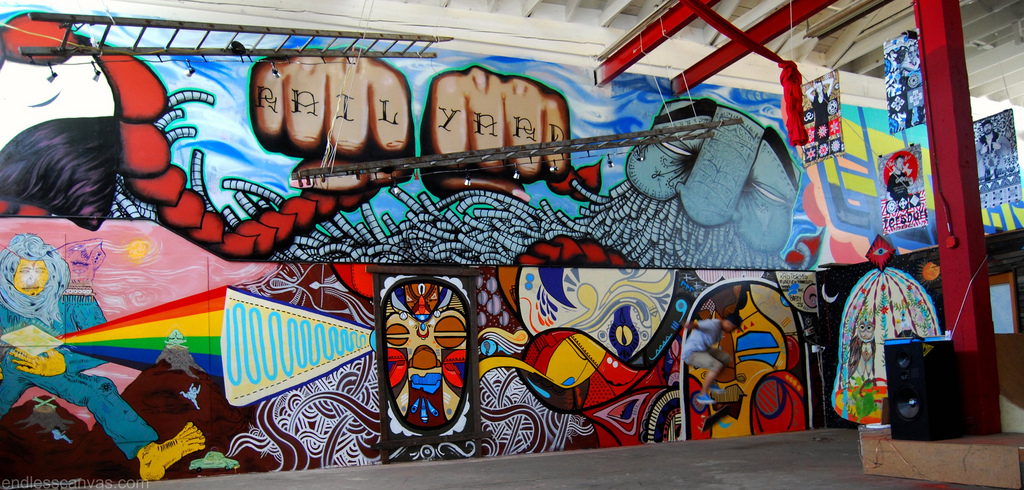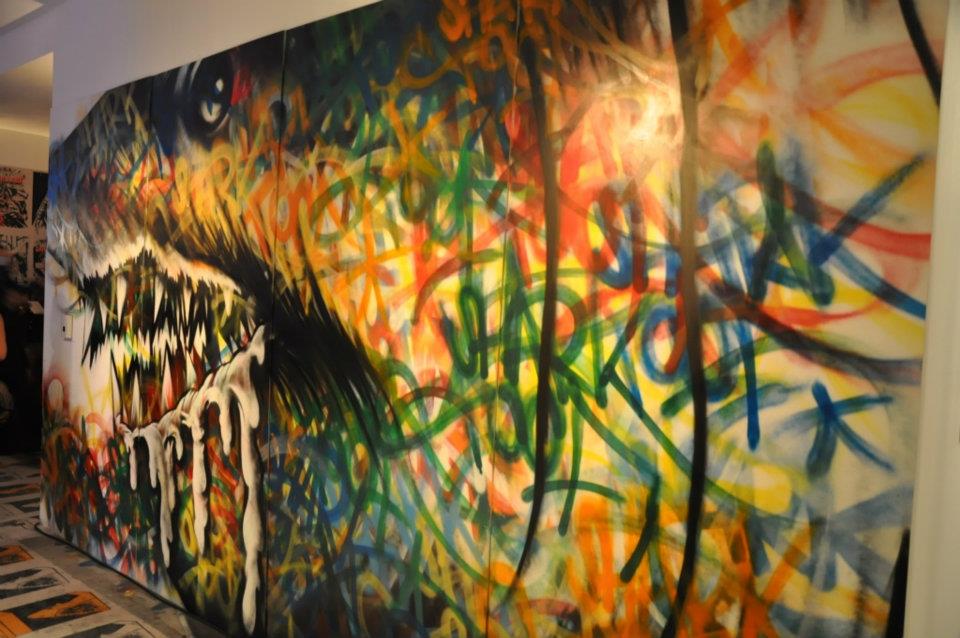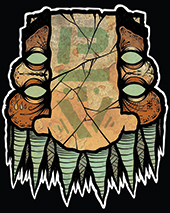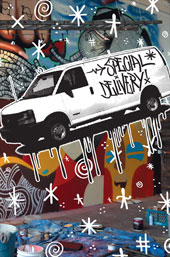Article written by: “Yourself” – August 2011
If you ask a person on the street “Is there a difference between advertising, murals and graffiti?” they would probably say “Yes, of coarse”, considering they each have their own definition. However, those in positions of power in the cities of Portland, Oregon and Los Angeles have made conflicting claims as to the significance of these definitions. Billboard companies have accused murals as being advertisements, and City offices claim that local murals are illegal graffiti. Meanwhile, graffiti and mural artists, who struggle to legally provide beauty and insight for their community, are stuck in between a web of legal code. The future of public expression in Portland and LA, and even America as a whole, is under compromise. Here are the signs of the probable ban on your right to public art.
As you may already know, corporations have the same constitutional rights as you, an actual human being, although a corporation cannot be held responsible and imprisoned like you would be. In 1997 AK Media, an advertising company, sued the city of Portland. AK media claimed that Portland’s codes that restricted advertising intruded upon their first amendment, freedom of expression. They also accused the city of favoring mural art, and claimed this art was also a form of advertising. The county court ruled that Portland’s sign code was unconstitutional, in favor of AK Media. In order for the city to avoid losing public money to a corporation, they were forced to apply the city sign codes to murals. After this ruling, in order to legally paint a mural, you would need a $1400 permit just like advertisers. AK Media was eventually bought out by Clear Channel, who picked up AK Media’s case and sued the city again in 2006. A group called the Portland Mural Defense attended the trial to represent Portland artists and support a more accessible mural policy. After this trial the city of Portland drafted a mural permitting process that allowed murals on commercial buildings, given that they pay a fee, and that the design remain on the building for at least 5 years. Because of this ruling, Portland has struggled since to create new murals that reflect it’s growing creative population, with many artists misinformed and afraid to even attempt at painting a public mural. To make things worse graffiti artists are constantly held back for participating in mural painting, when they are simply painting walls with permission.
In June of this year, a local Portland newspaper featured a front page article on Portland’s supposed graffiti “dilemma”. The story begins with a mural that was recently defaced with amateur graffiti, and introduces a newly hired graffiti investigator, making two officers solely dedicated to graffiti in this small city.The paper informs Portland’s citizens that this officer’s position, as well as a paid volunteer coordinator, costs “$158,600 in city funds”.The paper used the defaced mural as the “tear-jerker” of the story. This vandalization of a public art piece is one of the main examples in the article used to justify the graffiti abatement program’s rising expenses.
Ironically, the graffiti abatement program itself has attempted to stop other murals in Portland. At the same time that the previous article was published, two separate buildings received a graffiti abatement notice. This notice informed the owners that their building was “vandalized” with graffiti and that the nuisance must be painted over within 10 days of the notice. Otherwise, the city will contract a third party to paint over it and bill the owners. The problem with this notice, however, was that the walls were not “vandalized” at all. Both buildings were painted by multiple mural artists, with permission, using various media including spray paint (a common mural medium). One building was a grassroots community creative space hoping to beautify and represent the neighborhood with their exterior walls. The other was a newly opened gallery, named Samo Lives, hoping to do the same while showcasing artists they featured inside. The graffiti abatement program had “accidentally” confused two large scale multi-color neighborhood mural projects, as “graffiti”. How could they have made such an obvious mistake?
 (Above – Permission murals by Jules Muck declared as illegal graffiti.)
(Above – Permission murals by Jules Muck declared as illegal graffiti.)
Apparently, the graffiti abatement notices run on citizen complaints, and someone had complained that the murals were “graffiti”. However, the residents in both buildings claim each neighborhood was expressive of their appreciation for the new art. Additionally, local mural artists report stories about the graffiti abatement coordinator (the person who delivers the abatement notices), who supposedly calls in every new mural that uses spray paint while driving around town, to check if they have a registered mural permit. Although neither of the noticed murals obtained a permit, the mural permit coding is not enforced by the graffiti abatement program, which is a completely separate department. The mural code never even mentions the word “graffiti” or “vandalism” at all. Puzzling, is the fact that the grassroots community space reports that the mural project started after they had already painted over unsolicited tagging multiple times, which they never received an abatement notice for. The tagging issue for this building was virtually solved by the application of mural art, and the city of Portland even lists public art as a graffiti prevention measure. Portland’s graffiti abatement program is negligent of the fact that permission graffiti murals protect walls from actual graffiti tagging which is what the program is funded to eradicate, not public art.
In Portland, not only are authorized graffiti murals under attack by a city funded program, but even “graffiti art”, in the form of paintings inside art galleries. Endless Canvas, a group of photographers that document and publish mural and street art in the Bay Area, visited Portland in July to curate a group art show. The event was originally planned as a mural painting event to beautify a neglected industrial area, with additional work inside an art event space. However, after the news of the other neighborhood murals under legal scrutiny, the event space decided to have all of the murals painted inside. On the same night of the opening for the mural show, the Samo Lives gallery, mentioned earlier, had a separate art show in the same area and was visited by the newest graffiti officer. This officer apparently harassed and intimidated the gallery owner, accusing them of bringing in graffiti vandals into town and also reminded them of the fees that would occur from their own mural that they did not paint over. The officer also told the gallery owner that they would be responsible for any new graffiti in the area, accusing the owner of supporting local “vandalism”. Around the same time, an unmarked police car was stationed on the perimeter of the Endless Canvas show, supposedly profiling and pulling aside anyone going in the direction of the show. The police talked to the event organizers as well, informing them that their show would be shut down, although the police never informed them what they were actually doing wrong. Are these the actions what Portland city officials agreed to allow the extra $158,600 in city funds for? Would this happen again to anyone else expressing themselves in an otherwise legal manner?
 ( “Special Delivery” indoor mural exhibit curated by Endless Canvas )
( “Special Delivery” indoor mural exhibit curated by Endless Canvas )
Unfortunately, the city of Los Angeles has many reported instances with big advertisers and graffiti abatement that are similar to those in Portland, only on a larger scale. Considering that one of the affected Portland mural walls was actually a private residential property, one would anticipate city officials restricting how we decorate own homes. This is essentially what officials of LA did to Barbara Black, a retired LA homeowner. Barbara decided to contact the local high school to have her fence painted by art students, who then painted abstract graffiti art to her delight. Without even receiving a first warning, Barbara was quickly given a violation notice from the city for $360, claiming that the mural was an “illegal sign”, because of the use of lettering in the mural. Barbara then raised money and paid the fee, but afterwards inspectors decided that the artwork was now an “illegal mural” and the fee for the violation would be close to $2,000. Barbara, who is retired, could not pay this last fee and was forced to destroy the mural by painting over it. All the while, in the same neighborhood as Barbara, are two “more traditional” murals on her neighbor’s property, who have not received any notices. To make Barbara’s story even more bitter is the fact that, as of 2010, LA is reported to have 4,000 illegal billboards that are without proper city permits, and will most likely go unchecked by the city. That said because some LA politicians are being funded by advertisers like Clear Channel and that the city is also apparently intimidated by the Portland vs. Clear Channel case. Like Portland, LA has attempted many times to reduce it’s own epidemic of billboards and super-graphics, but after placing these bans the city was sued by Clear Channel and other advertising companies at least 4 times since 2001.
These legal cases with advertisers have apparently led to LA placing a hold on the legality of any new murals. LA was once considered “The Mural Capitol of the World”, but today is losing recent and historical murals due to a combination of misdirected graffiti abatement and amateur graffiti taggers, who lack the mentorship of older generations for “graffiti ethics” (not tagging schools, houses, murals). This city’s deteriorating mural community could be restored very quickly by the city’s world-famous graffiti artists, who have already contributed significantly to LA’s mural community. Sadly, LA’s vibrant and historical graffiti culture is both praised and damned by those in power. The fine art market in LA has increasingly acknowledged graffiti practitioners as “artists”, with multiple galleries selling graffiti art and a recent graffiti art show at the LA MOCA, the largest graffiti art exhibit at a museum of it’s kind. But while the “authorities” of art aesthetic puts up graffiti art for sale inside galleries, the authorities of law spend copious amounts of money destroying their work in the public. In 2009, the US Army Corps spent $837,000 of federal money to paint over the graffiti on the LA River banks. Most notably is Saber’s “LA River Piece”, which was recognized in LA’s Natural History Museum and many graffiti artists would argue that the painting is a milestone in the history of contemporary art. Interestingly, this is the first time that the federal government has been this involved with graffiti abatement. Could the LA river paintings be that intimidating to the American political system? Could the graffiti paintings on the LA river, or any wall featuring “illegal art”, signify a marginalized community with no other means of public representation?
 (Saber’s famous LA River Piece. 1997-2009)
(Saber’s famous LA River Piece. 1997-2009)
For many graffiti artists and muralists, their intention is to represent themselves as individuals, or represent a community that they are a part of. These communities, however, are unable to be represented in the same public space they occupy because corporations have enabled restrictions against their freedom of speech, while those same corporations dominate the visual and mental landscape. These communities also have a more limited resource of local mural artists, because of the fact that it is a complicated endeavor for a beginner to paint a legal mural, and also because the local graffiti abatement programs will not recognize those who paint graffiti art as “artists”. However, the most efficient way for the cities like Portland and LA to restore their mural culture is to utilize a group of artists who are experienced at painting large scale, quickly, with common materials, and would do it all for free. These requirements would all be supplied by a seasoned graffiti artist. Many other cities have recognized the individual’s historical urge to paint cave-walls, by allowing un-permitted murals, and provide unrestricted “free-walls” for the youth, who would otherwise have little exposure to visual art.
Why are American cities like Portland and LA spending so much time and money on graffiti abatement while chronically cutting funding for education of the arts? Why are these cities also being defaced with an accelerating rate of often illegal advertisements, after each city had attempted to ban such proliferation? All the while individuals are condemned for expressing themselves freely in public, whether it is indeed illegal graffiti, or simply an authorized mural. These issues of advertising, murals and graffiti are all interrelated, in that they address how public space is used, and who has control over them. Considering the surprising consequences of cities expressing themselves and speaking out against big advertising, like Portland and Los Angeles, any city could also be at risk of losing their constitutional rights to benefit the interests of corporations. With these limitations on the accessibility of public art, the individual has fewer options for public expression, and is more likely to participate in illegal graffiti. These issues happening in Portland and LA foreshadow the demise of our constitutional freedom of expression, that is, if we do not recognize the inequalities taking place around us.
Related Links:
Mobile Mural Lab in LA – mobilemurallab.com
 Imagine relaxing in your apartment after work with your family to hear a knock at the door. Upon answering it, you learn that it’s the local police department and they have a warrant to search you home. You sign the paper as they barge through the door and go straight to your room. They leave, only after taking your drawings, silk-screens, books, and take pictures of your stickers and signatures of friends who have passed through. Later in court, you learn that the police were given false information that you were a well known graffiti artist by a snitch that was arrested for vandalism. They use pictures of stickers of famous graffiti artists and tags of your friends to convict you of being someone you are not. You now are facing months and possibly more in jail…
Imagine relaxing in your apartment after work with your family to hear a knock at the door. Upon answering it, you learn that it’s the local police department and they have a warrant to search you home. You sign the paper as they barge through the door and go straight to your room. They leave, only after taking your drawings, silk-screens, books, and take pictures of your stickers and signatures of friends who have passed through. Later in court, you learn that the police were given false information that you were a well known graffiti artist by a snitch that was arrested for vandalism. They use pictures of stickers of famous graffiti artists and tags of your friends to convict you of being someone you are not. You now are facing months and possibly more in jail…











